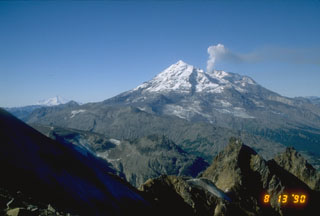Report on Redoubt (United States) — 29 April-5 May 2009
Smithsonian Institution / US Geological Survey
Weekly Volcanic Activity Report, 29 April-5 May 2009
Managing Editor: Sally Sennert.
Please cite this report as:
Global Volcanism Program, 2009. Report on Redoubt (United States) (Sennert, S, ed.). Weekly Volcanic Activity Report, 29 April-5 May 2009. Smithsonian Institution and US Geological Survey.
Redoubt
United States
60.485°N, 152.742°W; summit elev. 3108 m
All times are local (unless otherwise noted)
During 29 April-5 May, AVO reported that elevated seismicity from Redoubt and a persistent thermal anomaly over the summit lava dome detected on satellite imagery were consistent with continued lava-dome growth. Changes in the size and shape of the dome confirmed growth; the volume of the dome was an estimated 25-30 million cubic meters. Occasional small rock avalanches originating from the N side of the lava dome produced minor low-level ash emissions. The web camera showed steam-and-gas plumes rising from the lava dome. During 2-3 May, seismicity increased markedly and minor ash emissions were seen on the web camera. More frequent rockfalls were also detected. On 4 May, steam plumes with possible minor amounts of ash rose several thousand feet above the summit and drifted SE. Seismicity during 4-5 May continued to slowly increase. AVO warned that a significant explosive event was likely in the coming days.
Geological Summary. Redoubt is a glacier-covered stratovolcano with a breached summit crater in Lake Clark National Park about 170 km SW of Anchorage. Next to Mount Spurr, Redoubt has been the most active Holocene volcano in the upper Cook Inlet. The volcano was constructed beginning about 890,000 years ago over Mesozoic granitic rocks of the Alaska-Aleutian Range batholith. Collapse of the summit 13,000-10,500 years ago produced a major debris avalanche that reached Cook Inlet. Holocene activity has included the emplacement of a large debris avalanche and clay-rich lahars that dammed Lake Crescent on the south side and reached Cook Inlet about 3,500 years ago. Eruptions during the past few centuries have affected only the Drift River drainage on the north. Historical eruptions have originated from a vent at the north end of the 1.8-km-wide breached summit crater. The 1989-90 eruption had severe economic impact on the Cook Inlet region and affected air traffic far beyond the volcano.
Source: US Geological Survey Alaska Volcano Observatory (AVO)

